Introduction
Curious or confused about flat panel speakers? Join us on a journey as we explore their diverse types, from classic electrostatic speakers to cutting-edge piezo innovations. We will summarize their working principles, unique advantages and disadvantages. These sleek devices seamlessly blend aesthetics with exceptional audio performance, transforming the way we experience sound.
Types of Flat Panel Speakers
What is a flat panel speaker? As the name suggests, flat panel speakers utilize the vibrations of a flat panel or membrane to produce sound, distinguishing them from traditional cone-based speakers. This unique design has earned them the moniker of flat diaphragm speakers. Flat panel speakers employ various working principles to generate these vibrations, including electrodynamic, ribbon, electrostatic, and piezoelectric technologies. As a result, flat panel speakers can be categorized based on these diverse working principles.
1. Ribbon speakers
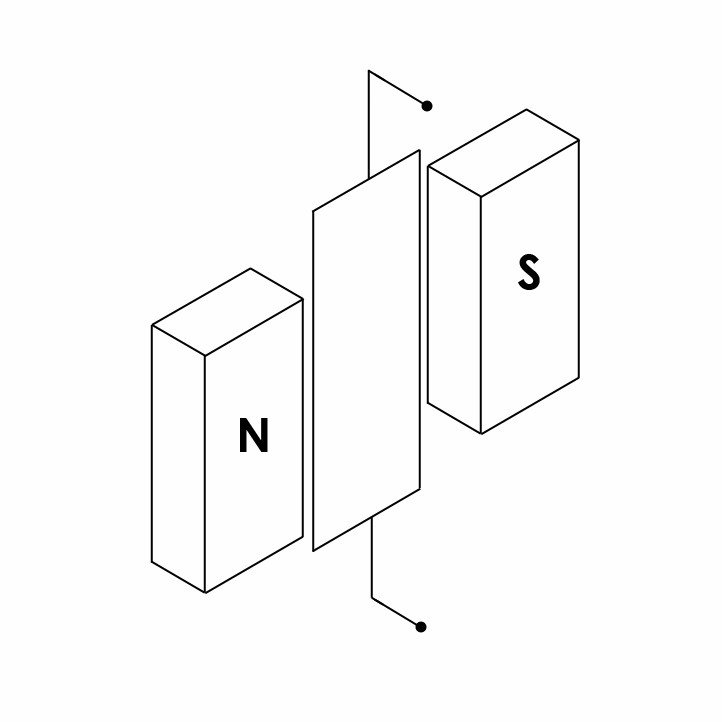
At the core of flat panel speakers lies a thin and conductive ribbon, serving as both the diaphragm and voice coil. Positioned within a transverse magnetic field generated by two permanent magnets and supported at each end, the ribbon speaker comes alive when an electrical current flows through it, creating sound through its interaction with the magnetic field. With its remarkably thin and lightweight design, the ribbon speaker excels in reproducing high frequencies with outstanding accuracy, making it a preferred choice for tweeters.

Within the realm of ribbon speakers, we encounter the fascinating domain of quasi-ribbon speakers, including notable offerings from Magnepan. These variations combine ribbons with a thin plastic film, typically made of polyester, which vibrates in response to the ribbon’s movements, thus generating sound waves. Quasi-ribbon speakers excel in delivering exceptional clarity and transparency, immersing listeners in a vast and captivating soundstage.
- Pros: Ribbon speakers boast a unique design that unravels unparalleled clarity and transient response, unveiling the most intricate audio details. The sound is highly transparent, and the expansive soundstage creates a captivating listening experience. Additionally, ribbon tweeters offer superior directivity compared to dome tweeters.
- Cons: Bass response may not match that of traditional cone speakers, but it can be augmented by incorporating a regular subwoofer. Moreover, ribbon speakers often come with a higher price tag compared to other speaker types. This is primarily due to their manufacturing process, which relies heavily on manual labor and lacks the efficiency of mass production methods.
2. Electrostatic speakers

Electrostatic speakers operate on the principle of electrostatic attraction and repulsion. Thin conductive diaphragms, sandwiched between charged stators, vibrate in response to the audio signal. This design enables detailed and transparent sound reproduction, often delivering an immersive listening experience. The simplicity of the electrostatic speaker design has sparked numerous DIY projects, allowing enthusiasts to explore and experiment with this technology.

- Pros: Electrostatic speakers, like ribbon speakers, excel in transparency and accuracy, making them well-suited for vocal, classical, and jazz genres. Their ability to faithfully reproduce intricate details of the audio enhances the listening experience.
- Cons: Electrostatic speakers have limited bass response, but this can be supplemented by incorporating a regular subwoofer. Additionally, over time, dust and debris may accumulate in the gap between the membrane and the stators, necessitating regular maintenance to ensure optimal performance.
3. Electrodynamic flat panel speakers
Another class of flat panel speakers utilizes electrodynamic exciter technology. These exciters closely resemble the drivers found in traditional cone speakers, comprising a voice coil and a permanent magnet. However, instead of driving a cone-shaped diaphragm, they power a flat panel. The primary purpose of employing a flat panel is to address the limited directivity associated with cone speakers, allowing for high-quality sound reproduction over a wider listening angle.
Flat diaphragm speakers vs. flat panel speakers
Flat diaphragm speakers are a subset of flat panel speakers. Smaller diaphragms in flat panel speakers are often constructed to be highly rigid to avoid resonance, employing materials such as composites with honeycomb cores. This design enables the diaphragm to move uniformly, akin to a piston. Additionally, the diaphragm is supported along its perimeter using a soft rubber surround, similar to what is found in conventional cone speakers. Tectonic is one of the companies that specializes in commercializing this type of speaker technology.
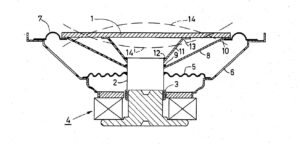
Distributed Mode Loudspeakers (DML)
Speakers with larger flat diaphragms often feature a different structure. The diaphragm or panel is typically supported at the corners or suspended freely, enabling a free boundary condition that encourages greater resonance within the panel. One or more exciters are attached to the panel using double-sided tape, and the mechanical integration relies solely on this adhesive connection, eliminating the need for additional mechanical support. This simple design has made it a popular choice for DIY projects showcased on platforms like YouTube. In fact, the design can be as straightforward as attaching an exciter to a pink insulation board from Home Depot. These speakers are also known as Distributed Mode Loudspeakers (DML), emphasizing their unique sound distribution characteristics.

How to improve the bass response of a DML
In order to examine the impact of exciters on the performance of the flat panel speaker, a brief experiment was conducted. Three distinct exciter models from Dayton, namely 5W, 24W, and 40W, were utilized. The exciter was affixed to a 24″x16″x1/3″ pink foam board. Sound Pressure Level (SPL) was measured using REW software and the results are displayed below.
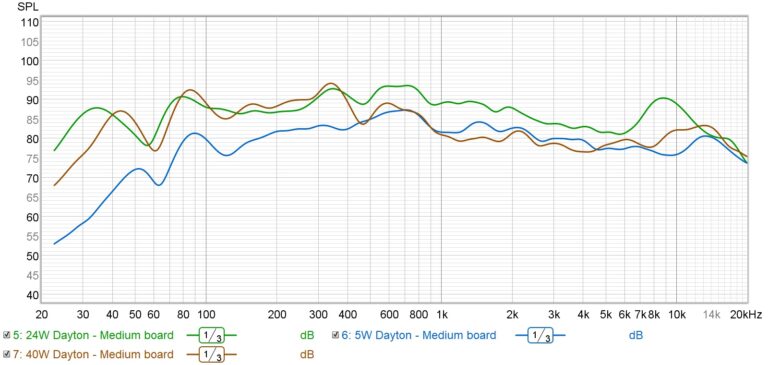
The impact of the panel on the Sound Pressure Level (SPL) was also examined. For this purpose, we attached a 5W exciter to pink foam panels of three different sizes: 24″x24″x1″ (large), 24″x16″x1/3″ (medium), and 16″x12″x1/4″ (small). The measurements were conducted to assess the influence of panel size on SPL.
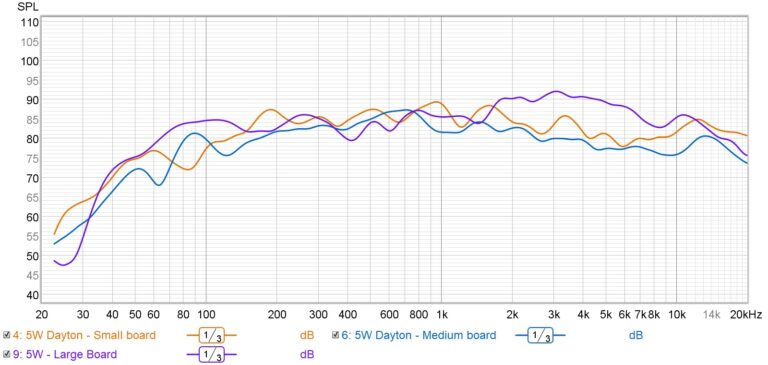
Based on the above results, it is evident that both the panels and exciters play a significant role in shaping the acoustic performance of flat panel speakers. In general, most combinations exhibit good mid-range frequency response. However, they tend to lack in bass response, particularly noticeable with the 5W exciter on the small panel. This deficiency can be attributed to both the exciter and the panel. The 5W exciter’s resonance frequency may not be sufficiently low, which hinders its ability to deliver satisfactory low-frequency response. Adjusting the spider stiffness can help reduce the resonance frequency, but excessive adjustments may adversely affect high-frequency response. Panel size also affects bass response, as larger and thicker panels provide better mechanical coupling with the exciter, lowering the system’s resonance frequency and extending the frequency response to the lower end.
Another observation is the non-flat SPL curves with dips and peaks, particularly in the low-frequency range, indicating the presence of panel resonance modes. Optimizing the panel shape and the attachment location of the exciter are crucial in minimizing these effects, although this aspect falls beyond the scope of this article.
Furthermore, all configurations exhibit weaker frequency response at the very high end (>15kHz), as the exciters are not specifically designed for this frequency range. Achieving optimal acoustic performance for flat panel speakers necessitates the optimization of both the exciter and panel characteristics.
- Pros: Like ribbon and electrostatic speakers, flat panel speakers provide a transparent sound quality. When constructed with lightweight materials such as foam board, they can exhibit high sensitivity compared to cone speakers, allowing them to fill larger spaces with sound even with a small 5W amplifier. Furthermore, flat panel speakers offer convenient integration options using double-sided tape.
- Cons: One drawback of flat panel speakers is their limited response in very low (<100 Hz) and very high frequency ranges (>15 kHz). However, as discussed previously, this can be improved by carefully optimizing both the exciter and the panel. It is important to note that the weight of the exciters may pose challenges for adhesive attachment using double-sided tape, especially under high ambient temperatures, which could result in tape creep. In such cases, alternative integration methods like using screws can be considered.
4. Piezo flat panel speakers
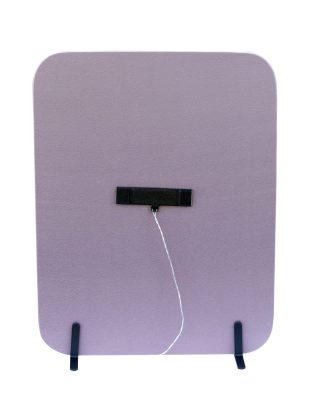
These speakers are similar to electrodynamic flat panel loudspeakers, with the key difference being the use of a piezo exciter to vibrate the panel instead of an electrodynamic one. Piezo exciters are generally thinner and more efficient compared to electrodynamic ones, with thicknesses as low as 1mm and up to three times greater efficiency. However, these piezoelectric speakers are not as popular due to the limitations of piezo exciters in generating sufficient sound pressure. Additionally, they often lack bass response due to the low displacement characteristics of piezoelectric exciters.
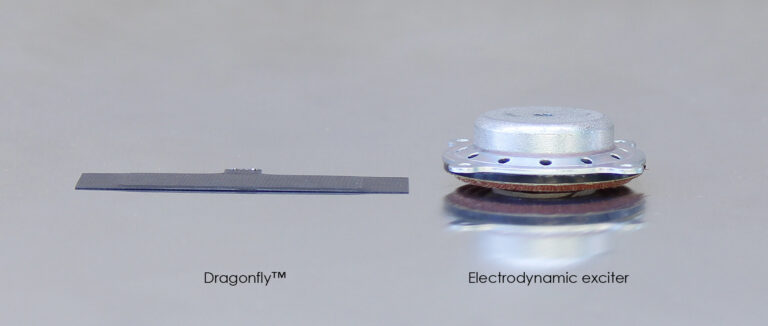
Our advanced piezo exciter, Dragonfly™, presents a solution to these challenges. The chart below demonstrates its remarkable performance when attached to a 16″x12″x1/4″ foam panel, delivering a wide frequency range from 60 to 20 kHz and generating high sound pressure levels. Generally, SPL curve of the piezo flat panel speaker shows more variation with peaks and dips than the electrodynamic one. This is due to combination of resonance modes of both the piezo exciter and the panel. However, through optimization techniques such as adjusting the mounting location and panel material, or utilizing equalization, this can be effectively mitigated. With its exceptional capabilities, Dragonfly™ emerges as an excellent choice for various applications, including automotive, aerospace, and display technologies.

- Pros: Piezo speakers offer several advantages over electrodynamic panel speakers, including a lightweight and thin form factor, as well as high efficiency. They maintain the benefits of transparency and accuracy found in electrodynamic flat panel speakers.
- Cons: Designing piezo speakers to achieve a full frequency range can be challenging. They generally have lower power and lower sound output pressure levels compared to other speaker types. However, with further optimization and careful design considerations, these limitations can be mitigated as demonstrated with the Dragonfly™.
Conclusion
As technology continues to advance, flat panel speakers are at the forefront of audio innovation. Their ability to blend seamlessly into various environments, coupled with their impressive sound reproduction capabilities, opens up a world of possibilities for both audio enthusiasts and professionals. Whether you seek the transparency of ribbon speakers, the versatility of electrodynamic exciters, the efficiency and full range capability of piezo exciters, or the immersive experience of electrostatic speakers, the realm of flat panel speakers has something to offer for everyone.









